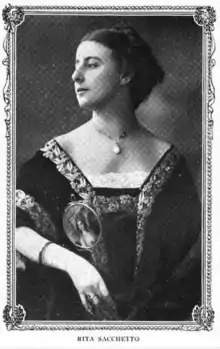Rita Sacchetto
Margherita "Rita" Sacchetto (15 January 1880 – 18 January 1959) was a German dancer, film actress, and screenwriter.
Rita Sacchetto | |
|---|---|
 Rita Sacchetto, from a 1909 publication | |
| Born | Margherita Sacchetto 15 January 1880 |
| Died | 18 January 1959 (aged 79) |
| Occupation(s) | Dancer, actress, screenwriter |
| Years active | 1905–1924 |
| Spouse | |
Early life
Margherita Sacchetto was born in Munich, in what was then the German Empire, on 15 January 1880. Her father was from Venice, and her mother was Austrian. She trained as a dancer in Munich.[1][2]
Career

Sacchetto made her debut in 1905 at the Munich Künstlerhaus.[3] Gustav Klimt and Koloman Moser designed the sets for her performance in 1906.[4] She toured internationally from 1908 to 1910 with dancer Loie Fuller,[5] including a show at the Metropolitan Opera in 1910,[1][6] and a dance about women's suffrage set to the music of Edvard Grieg, performed at the New Theatre, also in 1910.[7] She also ran a dance school in Berlin from 1916 to 1918,[8] with students including Rahel Sanzara, Anita Berber, Hansi Burg, and Valeska Gert.[9] Among her neighbors in Berlin was the scientist, Max Born, who recalled her as "a very beautiful woman" with "dazzling" students.[10]
She was known for developing a style called tanzbilder, which involved novel dance interpretations of great works of art, with remarkable costumes designed by Sacchetto herself.[11][12] Caroline V. Kerr of Theatre magazine described Sacchetto in 1909 as "wholly human, of fascinating naiveté, captivating in her exuberance of temperament, in her grace and charm."[13] Ben Ali Haggin painted Sacchetto's portrait in one of her best-known costumes, titled "En Crinoline".[14] At the peak of her dance career, she was a frequent guest of European royalty, including Queen Margherita of Savoy, Nicholas II of Russia's family, and Alfonso XIII of Spain.[15]
She appeared in several Danish and German silent films,[16] under contract to Nordisk Film,[17] between 1913 and 1917.[18] In the United States, she was known for her appearance in The Ghost of the White Lady (1914),[19] and In the Line of Duty (1914).[20] She wrote one film, En Død i Skønhed (1915), in which she also appeared.
In 1924, Sacchetto was accidentally shot in the foot by one of her husband's friends. This resulted in her retiring to Poland.[21]
Personal life
At age 37, Rita Sacchetto married the 24-year-old Polish nobleman and sculptor August Zamoyski on 5 May 1917, becoming the first of his four wives.[22] Sacchetto died in 1959, in Nervi, Italy, three days after her 79th birthday.
References
- Emily M. Burbank, "Rita Sacchetto" Putnam's Magazine (November 1909): 186-191.
- Caroline Caffin, Dancing and Dancers of Today (Dodd, Mead & Company 1912): 214-228.
- "Dance Pictures: The Cinematic Experiments of Anna Pavlova and Rita Sacchetto". www.screeningthepast.com. Retrieved Jul 13, 2020.
- Edward Ross Dickinson, Dancing in the Blood: Modern Dance and European Culture on the Eve of the First World War (Cambridge University Press 2017): 77. ISBN 9781107196223
- Rhonda K. Garelick, Electric Salome: Loie Fuller's Performance of Modernism (Princeton University Press 2009): 126. ISBN 9781400832774
- "Loie Fuller Shows her Dancing Girls" New York Times (December 1, 1909): 7. via ProQuest
- "Incarnating Woman Suffrage in a Dance" New York Times (May 22, 1910): SM8. via ProQuest
- Karl Toepfer, Empire of Ecstasy: Nudity and Movement in German Body Culture, 1910-1935 (University of California Press 1997): 235-237. ISBN 9780520918276
- Valeska Gert, Je suis une sorcière: kaléidoscope d'une vie dansée (Editions Complexe 2004): 259. ISBN 9782804800048
- Max Born, My Life: Recollections of a Nobel Laureate (Routledge 2014). ISBN 9781317699279
- Mary Simonson, "Dancing Pictures: Rita Sacchetto’s Tanzbilder" in Body Knowledge: Performance, Intermediality, and American Entertainment at the Turn of the Twentieth Century (Oxford Scholarship Online 2014). ISBN 9780199898015
- "Spanish Dancing" New York Times (May 1, 1910): XX3. via ProQuest
- "Rita Sacchetto: Munich's Famous Dancer" The Theatre (December 1909): 172-173.
- Gardner Teall, "Ben Ali Haggin, Painter of Portraits" Hearst's (November 1916): 308.
- "Coryphee Given Royalty Praise at Many Courts" Inter Ocean (17 November 1912): 13. via Newspapers.com

- "Rita Sacchetto To Appear in Films" Evening Sun (29 September 1913): 7. via Newspapers.com

- Isak Thorsen, Nordisk Films Kompagni 1906-1924, Volume 5: The Rise and Fall of the Polar Bear (Indiana University Press 2017): 123. ISBN 9780861969302
- Mary Simonson, "Dance Pictures: The Cinematic Experiments of Anna Pavlova and Rita Sacchetto" Screening the Past (August 2015).
- "A Feature that Charms" Moving Picture World (January 17, 1914): 276.
- "Noted Italian Actress in Military Drama" Dayton Herald (April 25, 1914): 9. via Newspapers.com

- "European Film Star Postcards: Rita Sacchetto". Jun 26, 2013. Retrieved Jul 13, 2020.
- Piotr Szubert, "August Zamoyski" Culture.pl.
External links
 Media related to Rita Sacchetto at Wikimedia Commons
Media related to Rita Sacchetto at Wikimedia Commons- Rita Sacchetto at IMDb
- Rita Sacchetto's listing on BFI